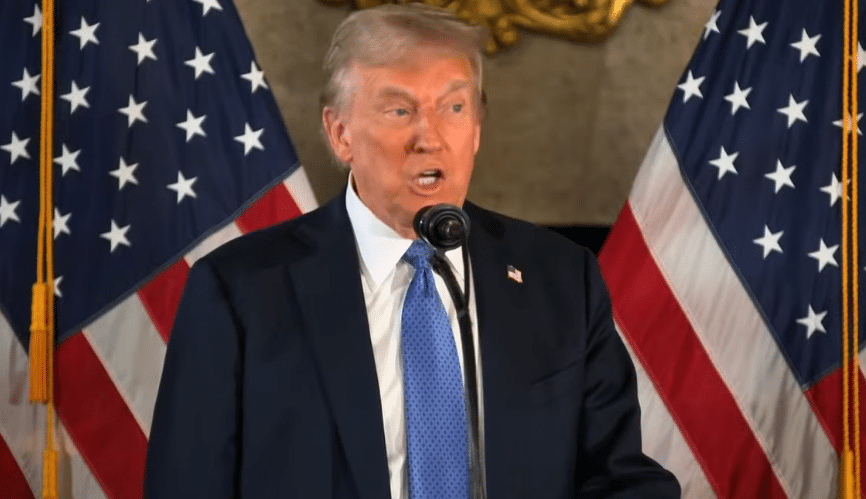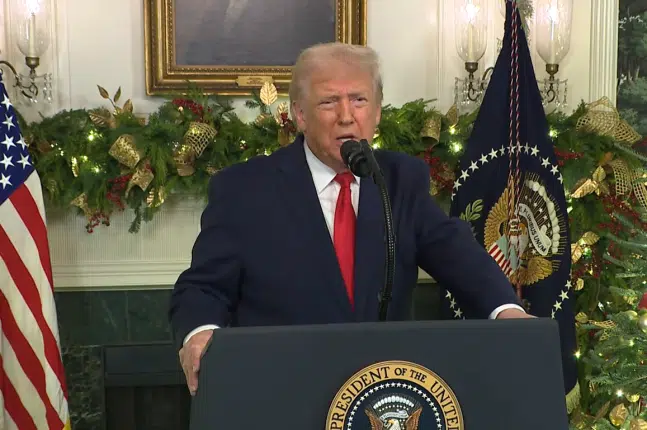
President-elect Donald Trump is weighing in on Congress’ latest omnibus spending bill, making continuing appropriations through Sept. 30, 2025, that came in at a whopping more than 1,500 pages all but declaring war on Congressional Republicans, who he threatened with party primaries in 2026 if they pass the current bill.
In a Dec. 18 post on Truth Social, Trump and Vice President-elect J.D. Vance in a joint statement urged the bill’s defeat, stating, “Congress is considering a spending bill that would give sweetheart provisions for government censors and for Liz Cheney. The bill would make it easier to hide the records of the corrupt January 6 committee—which accomplished nothing for the American people and hid security failures that happened that day. This bill would also give Congress a pay increase while many Americans are struggling this Christmas.”
Instead, Trump and Vance are pushing for a temporary spending bill so that the matter can be fully addressed next year plus an extension of the debt ceiling, writing, “Republicans want to support our farmers, pay for disaster relief, and set our country up for success in 2025. The only way to do that is with a temporary funding bill WITHOUT DEMOCRAT GIVEAWAYS combined with an increase in the debt ceiling. Anything else is a betrayal of our country…”
Trump in a separate post cited provisions extending the State Department’s censorship operation, the so-called Global Engagement Center in Title III, Sec. 301, and a provision shielding House “data” from subpoenas in Title VI, Sec. 605, potentially attempting to block any investigations of the January 6 Select Committee and Russiagate fiascos, writing, “the Communist Global Engagement Center, a project of Crooked Hillary Clinton, should not in any way, shape, or form be extended and, the shielding of the very corrupt J6 Unselect Committee of Political Losers and Thugs would be suicidal for any Republican approving it.”
To cap it all off, Trump in another post promised to primary House Republican members if they happen to bring a “clean” continuing resolution without extending the debt ceiling: “If Republicans try to pass a clean Continuing Resolution without all of the Democrat ‘bells and whistles’ that will be so destructive to our Country, all it will do, after January 20th, is bring the mess of the Debt Limit into the Trump Administration, rather than allowing it to take place in the Biden Administration. Any Republican that would be so stupid as to do this should, and will, be Primaried. Everything should be done, and fully negotiated, prior to my taking Office on January 20th, 2025.”
In sum, Trump does not support the current spending bill, which combines all of the appropriations bills into one — besides continuing resolutions in September, this is what gets passed every single year for the most part in recent memory — and especially if it does not extend the debt ceiling. And he opposes any temporary funding bill if it does not extend the debt ceiling. Finally, Republican members that go along with House and Senate Democrats on either approach will be primaried.
Trump’s concern over House and Senate Republicans acquiescing to bipartisan spending bills is well taken. Sometimes Republicans don’t even have the votes to pass Republican versions of these spending bills even when they defund things like government censorship operations over differences on other provisions.
But on the bipartisan bills, those always pass in the end.
For example, the most recent continuing resolution enacted in September passed the House 341 to 82 and the Senate 78 to 18 on bipartisan supermajorities.
In a snapshot of how almost every bipartisan continuing resolution or omnibus bill tends to be voted on, in the House, 132 Republicans were in favor, and 82 were opposed, with all Democrats voting in favor.
And in the Senate, 28 Republicans were in favor and 18 were opposed, and all Democrats were in favor.
Republicans are not united on these issues and have not been for years.
It’s like that on every bipartisan bill. Democrats vote largely in favor, while Republicans are divided. To be fair, Congress almost never votes on something conservative Republicans would support, and some conservative Republicans often vote against measures even when they do contain some good things. At the end of the process, leadership in recent history has just thrown up its hands and just passed the bipartisan bill.
September continuing resolutions (and those that follow in the fall) almost always set the stage for a year-end omnibus spending bill, wherein usually some or all of the twelve appropriations bills are combined into one and then overwhelmingly passed on a bipartisan basis.
It barely matters which parties are in power.
In fact, an April 2024 Congressional Research Service report noted that 135 out of the last 137 appropriations measures enacted were consolidated to include multiple titles from Fiscal Year 2012 through Fiscal Year 2023: “In recent practice, the vast majority of regular appropriations bills have been signed into law as part of omnibus appropriations measures. At least one omnibus measure containing multiple regular appropriations bills was enacted for each of the 12 fiscal years from FY2012 through FY2023 (see Figure 1). Over this period, all but two (135 out of 137) regular appropriations bills signed into law were enacted as part of omnibus appropriations measures.”
It’s like clockwork.
When media commentators describe Congress as a so-called “uniparty,” this is what they’re talking about, where overwhelming, bipartisan and often veto-proof majorities in both chambers will enact omnibus spending bills, debt ceiling bills, continuing resolutions, National Defense Authorization Acts, Foreign Intelligence Surveillance Act extensions and so forth with very little debate or opportunities to amend them.
And yet these are the bills that members know are going to pass. Occasionally, there will be attempts to attach riders to these, for example, a Republican House negotiating with a Democratic president on a debt ceiling to enact sequestration to hold the line on discretionary spending going forward with budget caps, as happened in 2011 and 2023.
On that count, eliminating the debt ceiling altogether might be a terrible idea: The only two times the American people saw any pause or freeze in discretionary spending — i.e. budget sequestration — the past two decades was when the debt ceiling was used as leverage by Republicans when in opposition to a Democratic president. In the 2010s, this approach was successful at substantially reducing the deficit, however, this time around any savings are more than being offset by Social Security and Medicare spending exploding amid the Baby Boomer retirement wave, with the national debt now up to almost $36.2 trillion.
Trump for his part does not appear to believe the debt ceiling provides him with an leverages in 2025, calling it a “trap,” stating, “Sounds like the ridiculous and extraordinarily expensive Continuing Resolution, PLUS, is dying fast, but can anyone imagine passing it without either terminating, or extending, the Debt Ceiling guillotine coming up in June? Unless the Democrats terminate or substantially extend Debt Ceiling now, I will fight ‘till the end. This is a nasty TRAP set in place by the Radical Left Democrats! They are looking to embarrass us in June when it comes up for a Vote.”
Otherwise, this process tends to play out, with occasional delays and partial government shutdowns, but always with the same outcome: temporary continuing resolutions pave the way for year-end omnibus spending bills.
Even in 2017 and 2018 when Republicans briefly controlled the House, Senate and White House, it was just more continuing resolutions and omnibus spending bills.
So, the proposal Trump laid out — a temporary continuing resolution combined with increasing the debt ceiling would not at all be an uncommon type of measure, it’s almost identical to the measure that just passed in September that kicked the debt ceiling into June 2025 — would similarly kick the can on appropriations into 2025 (although eliminating the debt ceiling from consideration for the foreseeable future), to be potentially followed up by yet another catch-all spending bill or maybe just more continuing resolutions.
Certainly, the details matter. Why not fight to build the border wall? Or defund the ongoing censorship operations by the Department of Homeland Security, the Cybersecurity and Infrastructure Security Agency, the FBI, the Department of Defense and the State Department? Or prohibit corporate and government Diversity, Equity and Inclusion (DEI) programs that clearly violate Title VII of the Civil Rights Act? The list goes on.
There’s a lot of things Republicans often propose to do in their versions of spending bills that never seem to wind up in these consolidated spending bills — because they are not united and so do not have the votes.
Optimistically, Trump might be setting the stage for Congress to get back to work on all twelve individual appropriations bills in 2025 with Republicans in command of the House, Senate and White House. But for now, House and Senate Republicans remain extremely divided on what to do on spending, a dynamic that will still be difficult to change in 2025. Stay tuned.
Correction: The most recent debt ceiling deal was in 2023, not 2021.
Robert Romano is the Vice President of Public Policy at Americans for Limited Government.






